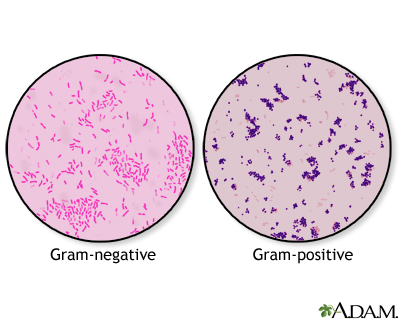Gram stain
A Gram stain is a test used to identify bacteria. It is one of the most common ways to quickly diagnose bacterial infection in the body.
How the Test is Performed
How the test is performed depends on what tissue or fluid from your body is being tested. The test may be quite simple, or you may need to prepare ahead of time.
- You may need to provide a sputum, urine, or stool sample.
- Your health care provider may use a needle to take fluid from your body to test. This could be from a joint, from the sac around your heart, or from the space around your lungs.
- Your provider may need to take a tissue sample, such as from your cervix or skin.
The sample is sent to a laboratory.
- A small amount is spread in a very thin layer on a glass slide. This is called a smear.
- A series of stains are added to the sample.
- A lab team member examines the stained smear under the microscope, looking for bacteria.
- The color, size, and shape of the cells help identify the specific type of bacteria.
How to Prepare for the Test
Your provider will tell you what to do to prepare for the test. For some types of tests, you will not need to do anything.
How the Test will Feel
How the test will feel depends on the method used to take a sample. You may not feel anything, or you may feel pressure and mild pain, such as during a biopsy. You may be given some form of pain medicine so you have little or no pain.
Biopsy
A biopsy is the removal of a small piece of tissue for lab examination.

Why the Test is Performed
You may have this test to diagnose an infection caused by bacteria. It can also identify the type of bacteria causing the infection.
This test can help find the cause of various health problems, including:
- Intestinal infection or illness
- Sexually transmitted diseases (STDs)
- Unexplained swelling or joint pain
- Signs of a heart infection or fluid buildup in the thin sac that surrounds the heart (pericardium)
- Signs of infection of the space around the lungs (pleural space)
- Cough that will not go away, or if you are coughing up material with a foul odor or odd color
- Infected skin sore
Normal Results
A normal result means that no bacteria or only friendly bacteria were found. Some types of bacteria normally live in certain areas of the body, such as the intestines. Bacteria normally don't live in other areas, such as the brain or spinal fluid.
Talk to your provider about the meaning of your specific test results.
What Abnormal Results Mean
Abnormal results may indicate an infection. You may need further tests, such as a culture, to find out more about the infection.
Risks
Your risks depend on the method used to remove tissue or fluid from your body. You may have no risk at all. Other risks are rare, but may include:
- Infection
- Bleeding
- Heart or lung puncture
- Collapsed lung
Collapsed lung
A collapsed lung occurs when air escapes from the lung. The air then fills the space outside of the lung between the lung and chest wall. This buil...
 ImageRead Article Now Book Mark Article
ImageRead Article Now Book Mark Article - Breathing problems
- Scarring
Reviewed By
Linda J. Vorvick, MD, Clinical Professor, Department of Family Medicine, UW Medicine, School of Medicine, University of Washington, Seattle, WA. Also reviewed by David C. Dugdale, MD, Medical Director, Brenda Conaway, Editorial Director, and the A.D.A.M. Editorial team.
Plourde AR, Beavis KG. Specimen collection and handling for diagnosis of infectious diseases. In: McPherson RA, Pincus MR, eds. Henry's Clinical Diagnosis and Management by Laboratory Methods. 24th ed. Philadelphia, PA: Elsevier; 2022:chap 66.
Wojewoda CM, Stempak LM. Medical bacteriology. In: McPherson RA, Pincus MR, eds. Henry's Clinical Diagnosis and Management by Laboratory Methods. 24th ed. Philadelphia, PA: Elsevier; 2022:chap 57.

 All rights reserved.
All rights reserved.